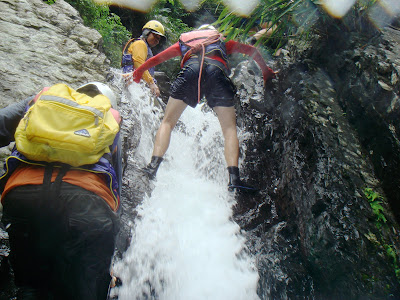It has become a tradition for us that Thursday night is rock-climbing night. I teach an extra class in the evening after my regular teaching is over on Thursdays and as soon as I am able I race home to An-ping on our scooter so that I can make the quick transition to rock-climbing mode. In fact this is not really as dramatic as it sounds; it involves me changing clothes and helping Andrea to check that we've got everything we need. Then we usually meet our friends downstairs and scoot off together towards Hutoupi.
Very close to Hutoupi is an abandoned outdoor activity centre. This is where we climb our 'rocks'. Of course, they're not real rocks but instead we climb an artificial climbing wall covered in hand holds. The objective is to make our way from one side of the climbing wall (we usually start from the left) to the other side without touching the ground, relying only on whatever nooks, crannies, or crevices we can find on the wall for our hands and feet.
Very close to Hutoupi is an abandoned outdoor activity centre. This is where we climb our 'rocks'. Of course, they're not real rocks but instead we climb an artificial climbing wall covered in hand holds. The objective is to make our way from one side of the climbing wall (we usually start from the left) to the other side without touching the ground, relying only on whatever nooks, crannies, or crevices we can find on the wall for our hands and feet.
This activity seems to be really good for building upper body strength. I don't think we've ever managed to get all the way from the left end of the wall to the right end. Your arms get pretty tired pretty quickly when you're using them to move the rest of your body. As I said before, we usually go rock-climbing on Thursday nights and this means that we need to take our own lighting; the facility is abandoned and the only other lighting we get is from the moon or from street lights outside the facility. The photos in this post were taken on a weekend when we happened to be going to Hutoupi Lake (close by) and thought to make the most of being in the area and go for a climb.
In a scene reminiscent of Stallone's Cliffhanger John successfully negotiates a difficult corner and outsmarts John Lithgow (not shown in photo).
In this short movie I make it most of the way around the wall only to stop because a particular foothold became quite painful with most of my weight concentrated on it through a very small area of my foot.
John stretching after climbing.

This is me recovering after hurting my lower back. I hung by my hands for about thirty seconds thinking it would be good for my back, stretching it out and freeing up the vertebrae but, instead, as soon as I tried to put my weight back on it I experienced terrible pain as if nerves in my spinal column were being pinched between the edges of vertebrae. It was awful but not the first time in my life that I have hurt myself after trying to stretch my back. Perhaps I'm better off just leaving a consistent weight on it. I really hope that I don't suffer serious back problems when I get older.


















